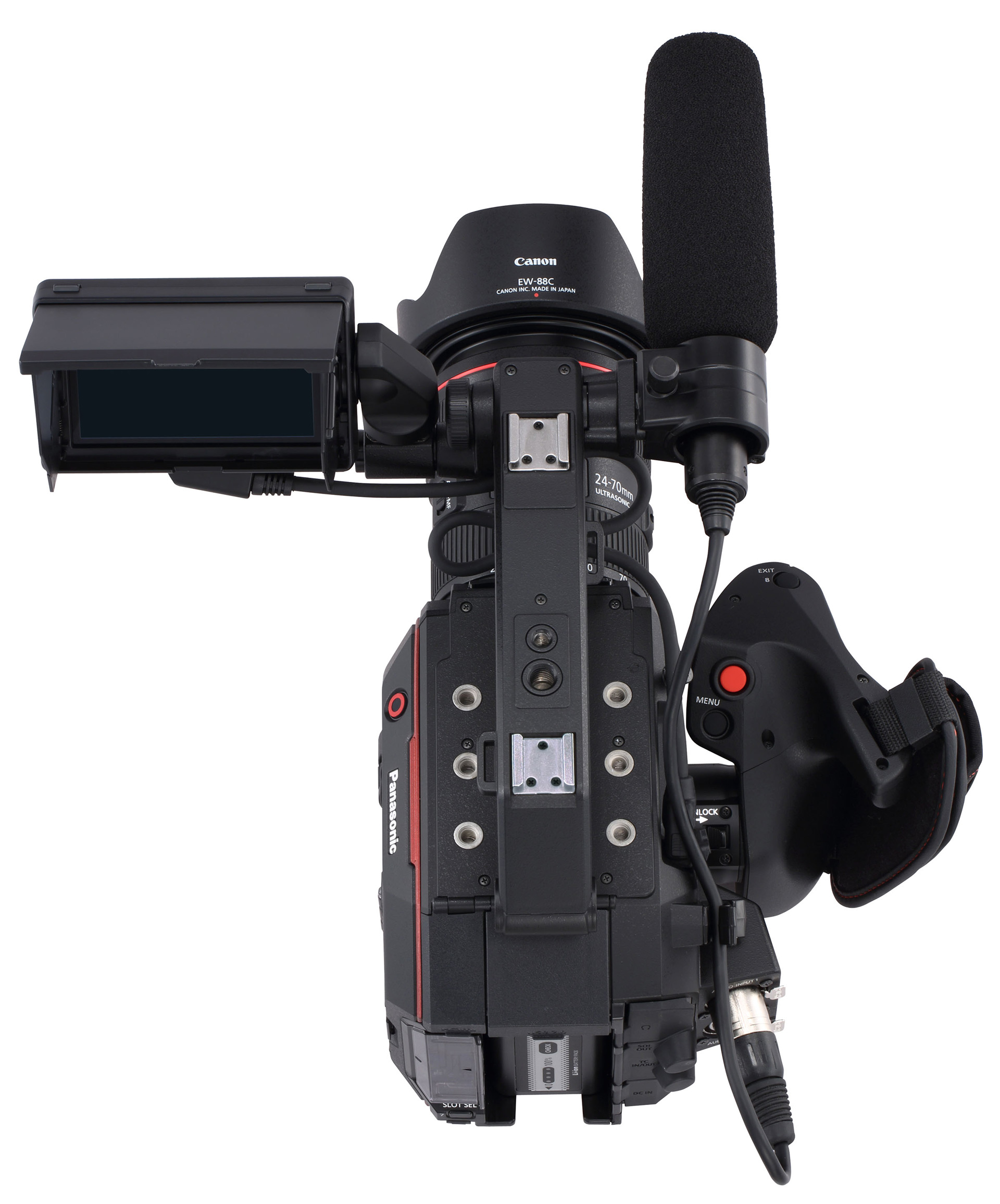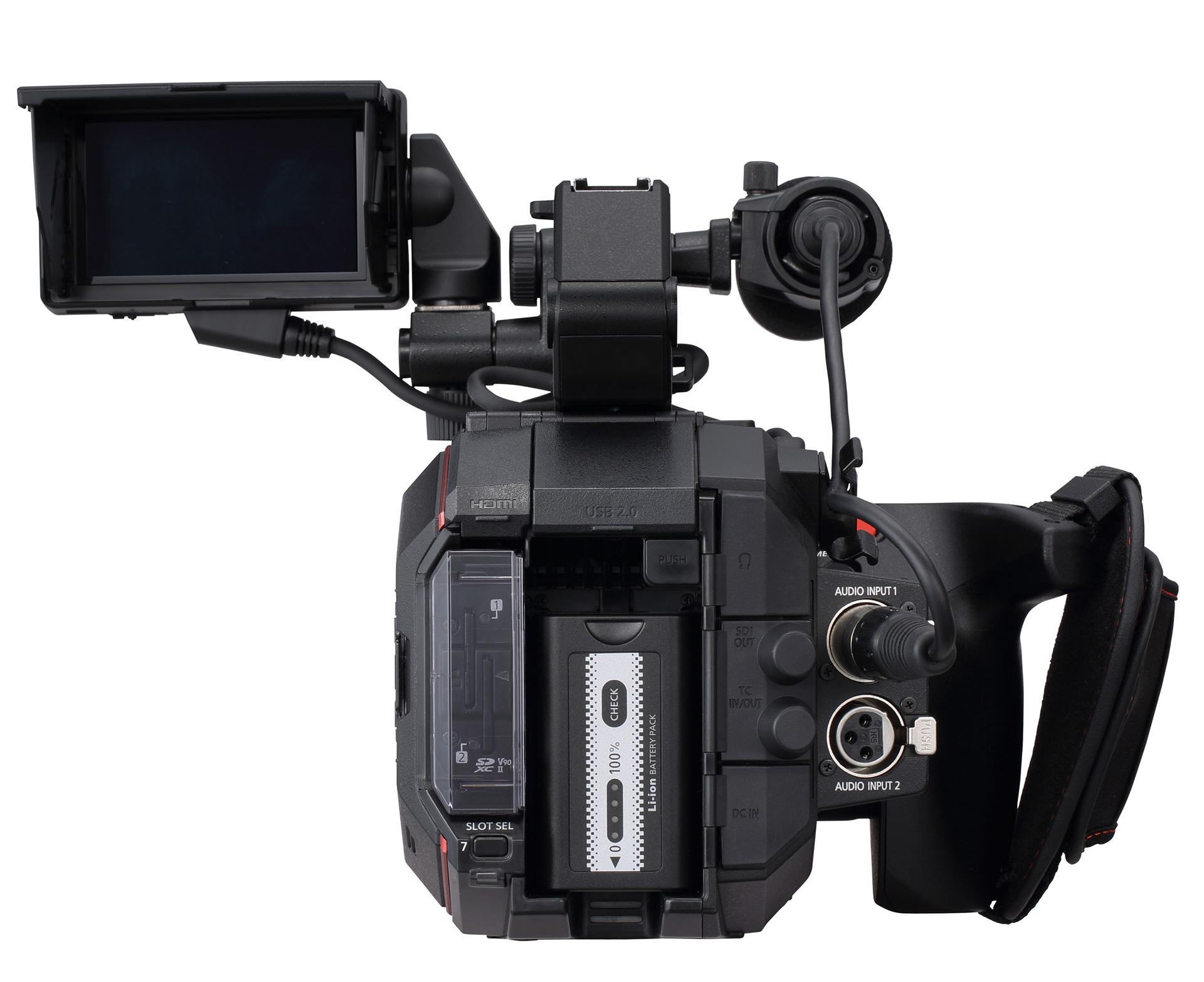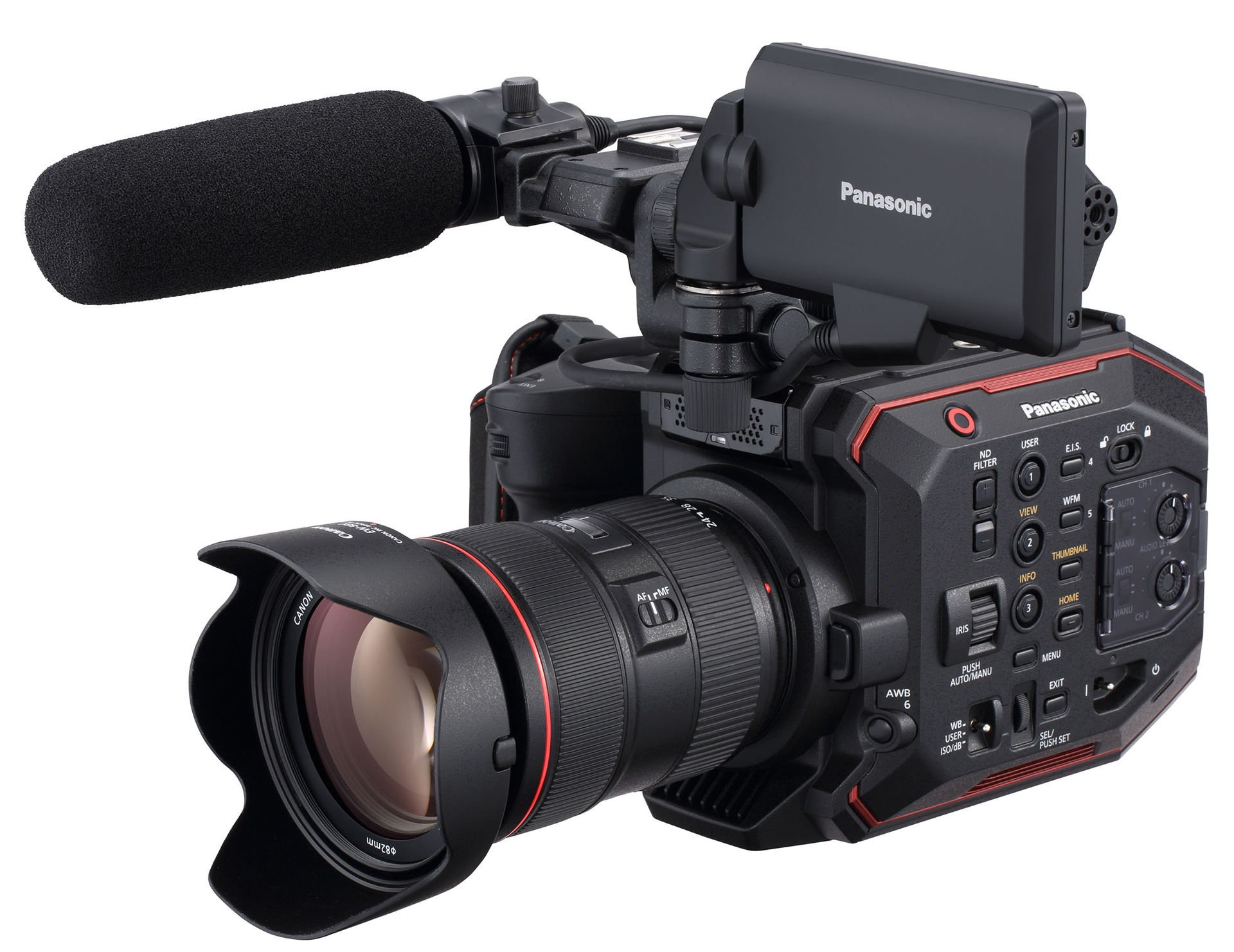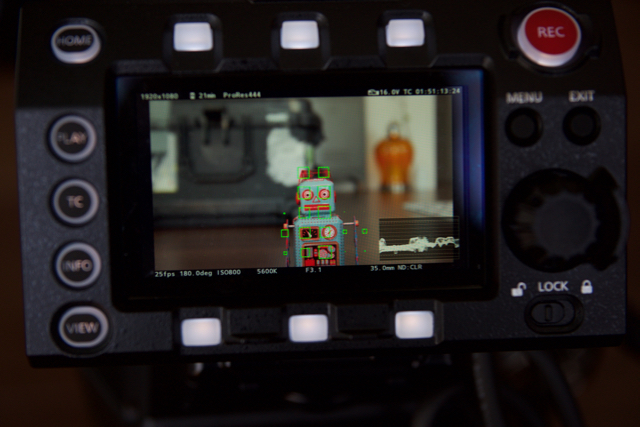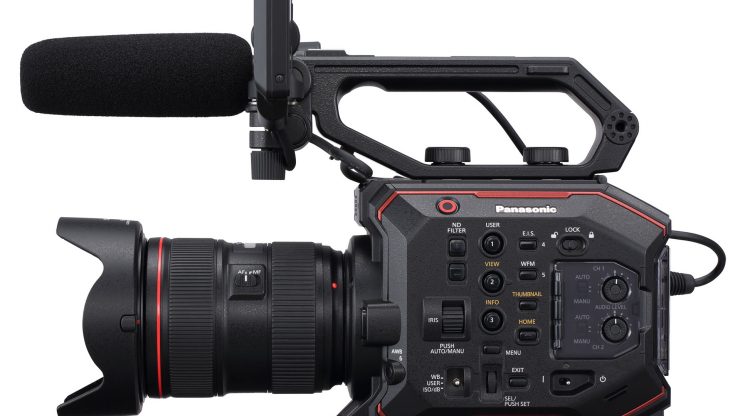
Today we know a lot more about the new Panasonic AU-EVA1 – a compact cinema camera featuring a newly-designed Super35 sized sensor (24.60mm x 12.97mm) with 5.7K resolution.
At Cine Gear this year I sat down with Mitch Gross, Panasonic’s Cinema product manager and he showed me the EVA1 for the first time. I’ll have to admit I was impressed with the preliminary specifications but there was still a lot we didn’t know. A first highlight is, well, the price. The camera will retail for $7,495 US – as promised previously it is under $8,000 US.
Frame Rates & Sensor
We all want to know about framerates and resolutions so let’s dive in. On first release, available bitrates will range from 8Mbps up to 150Mbps, depending on frame rate, resolution, and codec. In a future firmware update, 400Mbps recording will be added.
Panasonic are keen to talk up the benefits of downsampling from the 5.7K sensor. They say it has almost twice as many photosites as a 4K sensor, improving clarity and color rendition in the recorded video.
The EVA1 can record in several formats and compression rates, and offers up to 10bit 4:2:2 even in 4K. For in-camera recording, you can capture in DCI 4K (4096 x 2160), UHD (3840 x 2160), 2K (2048 x 1080), Full HD (1920 x 1080), and HD (1280 x 720). In a future firmware upgrade, EVA1 will offer All Intra compression for in-camera recording and 5.7K RAW output to third party recorders.
In S35 Mode 4096 x 2160 (4K) .MOV
- 422 Intra 400 Mbps (VBR) 29.97p, 24p, 25p, 23.98p (Firmware Update)
- 422 LongGOP 150Mbps (VBR) 29.97p, 24p, 25p, 23.98p
- 420 LongGOP 150M (VBR) 59.94p, 50p
- 420 LongGOP 100M (VBR) 29.97p, 25p, 23.98p
In S35 Mode 3840 x 2160 (UHD) .MOV
- 422 Intra 400 Mbps (VBR) 29.97p,25p, 23.98p (Firmware Update)
- 422 LongGOP 150Mbps (VBR) 29.97p, 25p, 23.98p
- 420 LongGOP 150M(VBR) 59.94p, 50p
- 420 LongGOP 100M (VBR) 29.97p, 25p, 23.98p
In S35 Mode 2048 x 1080 (2K) .MOV
- 422 Intra 200 Mbps (VBR) 59.94 50p (Firmware Update)
- 422 Intra 100Mbps (VBR) 29.97p, 24p, 25, 23.98p (Firmware Update)
- 422 LongGOP 100Mbps (VBR) 59.94p, 50p
- 422 LongGOP 50M (VBR) 29.97p, 24p, 25p, 23.98p
- 420 LongGOP 100M (VBR) 59.94p, 50p
- 420 LongGOP 50M (VBR) 59.94p, 50p
In S35 Mode 1920 x 1080 (FHD) .MOV
- 422 Intra 200 Mbps (VBR) 59.94 50p (Firmware Update)
- 422 Intra 100Mbps (VBR) 29.97p, 24p, 25, 23.98p (Firmware Update)
- 422 LongGOP 100Mbps (VBR) 59.94p, 50p
- 422 LongGOP 50M (VBR) 29.97p, 25p, 23.98p
- 420 LongGOP 100M (VBR) 59.94p, 50p
- 420 LongGOP 50M (VBR) 29.97p, 25p, 23.98p
For high-speed capture, the EVA1 offers up to 59.94fps/50fps for 4K/UHD, up to 120fps/100fps for 2K/Full HD, or 240fps/200fps (cropped area). All internally recorded.
- 2K/VFR Mode with Intra Codec will come later in a firmware update.
- S35: 4K/UHD 60 fps/50 fps 2K/HD 120 fps/100 fps
- Cropped Mode (4/3″) 2K/HD 240 fps/200 fps
I’m not surprised that 60p in UHD with 10bit 4:2:2 isn’t an internal option, since the bigger guns like the VariCam and VariCam LT handle those and more. However the option to have full 4K and UHD at 10bit 4:2:2 in 29.97, 24p and 23.976 with a VBR of 400Mbps is impressive. Unfortunately this codec won’t be available until a later date with a firmware update.
With an active resolution of 5720 x 3016, the EVA1 delivers more than 17.25 million photosites, nearly double the 8.8 million needed for DCI 4K (4096 x 2160). By starting at a higher native resolution, the 5.7K sensor yields a higher resolving image when downsampled to 4K, UHD, 2K, or even 720p. Panasonic also claim that the increased color information results in a finer, more accurate finished image.
HDMI and SDI Output
SDI OUT: BNC x 1, SDI REC REMOTE is supported 0.8 V [p-p], 75 Ω, 4K (6G), HD (3G/1.5G) Output format (4:2:2 10 bit)
- 4096 x 2160: 29.97p, 25p, 24p, 23.98p
- 3840 x 2160: 29.97p, 25p, 24p, 23.98p
- 1920 x 1080 : 59.94p, 50p, 59.94i, 50i, 29.97p, 29.97PsF, 25p, 25PsF, 24p, 24PsF, 23.98p, 23.98PsF
- 1280 x 720p: 59.94p, 50p
RAW Output 10bit
- 5760 x 3072: 29.97p, 25p, 24p, 23.98p
- 4096 x 2160: 59.94p, 50p, 29.97p, 25p, 24p, 23.98p,
HDMI OUT: HDMI x 1, TypeA, HDMI REC REMOTE is supported, Viera Link is NOT supported
- 4096 x 2160:59.94p, 50p, 29.97p, 25p, 24p, 23.98p
- 3840 x 2160: 59.94p, 50p, 29.97p, 25p, 24p, 23.98p
- 1920 x 1080 : 59.94p, 50p, 59.94i, 50i, 29.97p, 25p, 24p, 23.98p
- 1280 x 720p: 59.94p, 50p
- 720×576: 50p
- Output format (4:2:0 8 bit): • 4096 x 2160: 59.94p, 50p • 3840 x 2160: 59.94p, 50p
Dual Native ISO
One unique trick the VariCams have is dual native ISO. If you want to learn more about this feature check out Matt’s excellent post here.
The AU-EVA1 doesn’t sport the same Dual Native ISO range of 800 and 5000 of the VariCam. On the EVA1 it’s 800 and 2,500. Still it’s an impressive feature that could give you clean images in low light shooting situations.
Panasonic has rated the EVA1 at 14 stops of dynamic range and the camera features full V-Log/V-Gamut capture to take advantage of that dynamic range in post. V-Log has log curve characteristics that are HDR ready and V-Gamut delivers a color space that will cover BT.2020.
Form factor and grip
The EVA1 comes in at only 2.65-lbs (1.2Kg, body-only) with a compact form factor (6.69” H x 5.31” W x 5.23” D) and a removable handgrip, however no viewfinder is offered. Because of its compact form factor, it can also be mounted on a drone, gimbal rig or jib arm. The camera has numerous mounting points and Panasonic is currently working with accessory makers to allow further customization of the camera.
A surprise is that the 3.5″(approx. 1,150,000 dots) LCD screen is a touch panel for menu selections, expand (image zoom) positioning and playback controls, although no autofocus functionality is available. The LCD has an adjustable backlight control, including a Power LCD mode for bright viewing conditions. Hopefully the image will be bright and crisp as some touchscreens lack a quality image.
Recording Media
the EVA1 records to readily-available, lower-cost SD cards. With two SD card slots, you can capture footage either with Simul Rec (simultaneous dual record) or Relay Rec (continuous record). There’s also One Shot Record, which enables single frame capture for stop motion videos.
You will need Video Speed Class V60 or faster for 2K/FHD VFR Mode* Intra Codec (with update). Slower V30 class cards will work fine for 200 Mbps, 150 Mbps. & 100 Mbps. V30 class for 50 Mbps.
The Mount
The EVA1 has a native EF-mount. I’ve heard many that lusted for a Micro Four Thirds camera but I’m pleased with the decision to have the larger sensor. The selection of EF-mount lenses is huge, making lensing simple – there are so many choices out there, from cine primes to zooms.
Behind the lens mount is an integrated ND filter wheel with two, four, and six stops. The EVA1 also allows the IR Cut to be swung out of the path to the sensor. Unique photographic effects and night vision imagery are possible with this control over infrared. Since both the ND filter and IR Cut filter operate electronically they can be controlled with a wireless remote control from smartphones and tablets.
The EVA1 will have a remote-control app for a tablet (iOS, Android) that enables users to control an EVA1 when the camera is used on a crane or jib. I like this idea a lot!
Video Assist features
- Peaking
- Expand (Image Zoom)
- Waveform, Zebras
- Spotmeter (Y-Get)
- Focus Squares, an array of green squares that grow in size when their local area appears to be sharp, to enable shooters to achieve critical focus.
Focus Squares is a feature that also comes from the VariCam LT to assist in getting focus the green boxes change size. Larger boxes means the subject is in focus.
Audio and Video I/O
EVA1 offers dual balanced XLR audio inputs with Dolby Audio encoding. The HDMI and SDI video outputs are both 4K-capable and each can be adjusted separately, allowing HD to be fed to a viewfinder or other third-party monitor while 4K is sent to an outboard recorder or monitor. The camera is also equipped with standard timecode functionality.
My final thoughts
The Panasonic EVA1 is an impressive entry in the sub $8,000 US cinema camera market. At $7495 the camera is going head to head with the Sony FS7 MKI and Canon EOS C200. It has solid internal codec options for UHD and HD capture as well as RAW output. We’ve been waiting a long time for 10bit 4:2:2 on a cinema camera that doesn’t cost $14K US. I feel it’s better than Canon’s new C200’s weaker internal codec.
10bit and 4:2:2 will give you a better image with less banding in the sky and other scenes with larger color gradations. Nothing ruins an image faster than that horrible banding. However if you don’t want to grade, and a baked-in look is preferred the lower bitrate and color space of the current lines from Sony and Canon perform very well. Shoot, edit and upload to Youtube is very common practice.
60p is becoming more common and I love it! Generally it’s plenty of slomo for me and hopefully the 4:2:0 LongGOP 150M(VBR) 59.94p, 50p option will look nice and clean for the occasional slowmo. I see the EVA1 fitting in nicely between the intended VariCam LT and GH5. The small, light body will make VariCam owners very happy if they need to fly the EVA1 on a gimbal or drone. If you’ve ever had a chance to shoot with a VariCam LT then you know how heavy it is. It’s a beast!
One feature many will want is DPAF type autofocus. Nothing about this was mentioned so I wouldn’t expect anything like what the Canon Cinema EOS cameras offer. EVA1 does have a One Shot push focus feature that could come in handy though.
I would like to see an affordable EVF option come to market. The Zacuto Gratical and Eye are the best value at this time but for many the $1,650 US entry fee is steep plus you will need a mounting system for it. Shooters will be relying on the included touch screen LCD if they don’t have an external monitor already so hopefully it has a bright sharp image that can be used outside on a sunny day. In most cases I actually prefer a high brightness monitor over an EVF.
Lastly we still haven’t seen any footage and in the end that’s what’s most important. The EVA1 is supposed to fit between a VariCam LT and GH5. I’m very curious to see how the color will match. The GH5’s color science is improved but I haven’t seen any side by side. It will be very cool if a profile will be available for all three cameras so they will match color wise easily in post. The Sony a7sii, a7rii don’t match the FS7 and FS5. Having matching color science would be a huge advantage.
All in all an impressive release and I can’t wait to get my hands on one. What do you think? Is the AU-EVA1 the camera you thought it be? Let’s talk in the comments section below.

